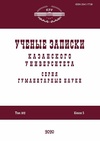Классификация китайских количественных числительных согласно критерию точности и целостности обозначаемых ими чисел
Classification of Chinese cardinal numerals based on the accuracy and integrity of the numbers they denote
Author(s): Lyudmila Lvovna BankovaSubject(s): Language studies, Morphology, Syntax, Semantics
Published by: Казанский (Приволжский) федеральный университет
Keywords: Chinese language; cardinal numerals; classification based on number accuracy; classification based on number integrity;
Summary/Abstract: The article considers the classification of cardinal numerals denoting integer numbers, fractions, multiple and approximate numbers, as well as decimals. Taking into account the critical analysis of the earlier classifications of these numerals, a unique view on the class entry, which is based on such characteristics of the denominated numbers as accuracy and completeness, was suggested. In the former case, based on the quantitative aspect accuracy, all numerals fall into definite and indefinite (followed by singling out of the relevant groups) and the word 半 (bàn ‘half’). As to the indefinite numerals, they are arranged depending on their ability to express numeric and non-numeric quantification. Beyond that, the article considers the problem of defining words that may be recognized as numerals. The solution is suggested to be within the framework of the prototype theory. The theory supposes that there is a core member of the lexico-grammatical category (a prototype) which possesses the full spectrum of typical features. As a result, the article concludes that the words that possess the numeric quantification represent the core of the category of numerals, and the words that possess a non-specific numeric quantification are at the periphery of the category.
Journal: Ученые записки Казанского университета. Серия Гуманитарные науки
- Issue Year: 163/2021
- Issue No: 4-5
- Page Range: 194-206
- Page Count: 13
- Language: Russian

